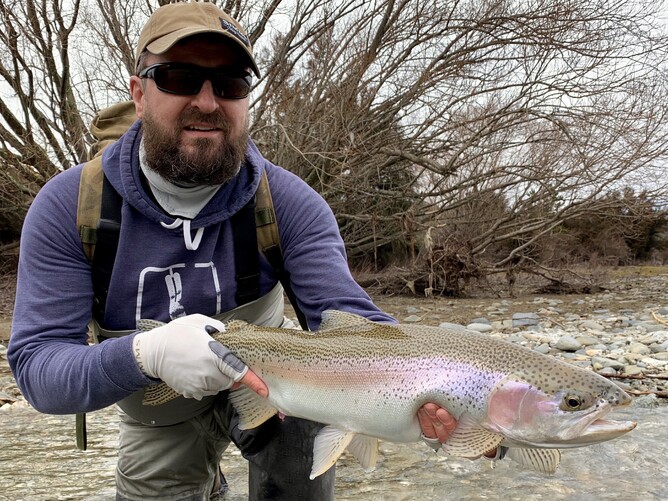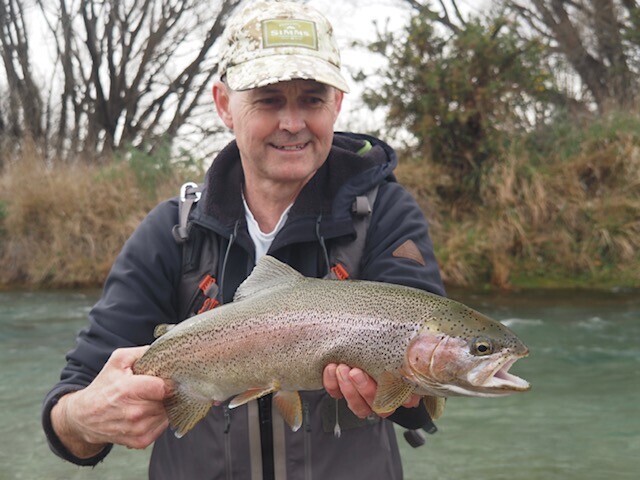There are many ways we can have our eggs and don’t we enjoy them all.
Scrambled with bacon, poached with bacon, fried with bacon, bacon eggs benedict, the list goes on! As much as our preferences change week by week, it’s the same as our approach to winter fishing each year and the variety of ways we fish and select our patterns improves each season with experience and as new materials come to light.
So this is far from just another glo bug article but a refresher and an overview of some of the many fly fishing tactics and techniques we employ using egg patterns to hopefully spark some of your latest and greatest ideas this winter.
What Are Glo Bugs?
Love them or loathe them, trout eat glo bugs. (or emerging trout imitations for those dry fly stalwarts struggling to justify their use).
Trout generally spawn across the winter months, when the water temps are cool and oxygen levels are high, essential requirements for eggs to develop. Exceptions to this could be in lake tributaries, offering cold water through the later months of summer, simulating the higher oxygen requirements of spawning.
When it comes time to spawn, female trout create redds in suitable gravels by scraping it out with their anal fins. This activity excites the males who fight for position and excitedly await the dropping of the eggs by the hen. As the eggs drop, Johnny On the Spot races in to fertilise them, and many milking eggs inadvertently end up drifting off downstream in the flow.
As trout are cannibals, and eggs are obviously an easy high protein meal, many become a target especially to larger rainbows that often follow the browns up earlier in the winter, or themselves as winter moves on. Needless to say, roe becomes a highly desirable winter staple for many fish.
When To Fish Egg Patterns
Whilst egg patterns can be effective at any time of the year, spawning season or otherwise, it is across the winter and early months of spring when they are most readily available and accepted as food. At other times they can provide colour on a dull day or in discoloured flows, but it is during the winter spawning runs where they come into their own.
Both dawn and dusk are prime time to fish egg patterns in any conditions, however many will find much greater success by switching to naturals throughout the day in normal water and clearer weather conditions. More eggs will get washed downstream in times of increased flows and so any high water or increasing flow can be a great time to break out those glo bugs.
Choosing The Right Colour Roe Imitation
You’re at a major disadvantage if you head out to the river with only one size and colour egg in your fly patch. Earlier on in the spawn the roe can be bright, and so oranges, tangerines etc can be at their most effective. Later on eggs lose their vibrance and so early girl and more muted tones can be the way to go.
Additionally, on low light days brighter colours will stand out and especially in discoloured flows, larger patterns in chartreuse, oranges etc will grab attention, and in lower, clearer or brighter conditions the sensible option is to stay smaller and with more neutral tones.
While much of the above applies to moving water, similar advice can be followed when fishing lakes. However in stillwater situations eggs can be washed down from the stream mouths or found suspended in the water column at any time making them a good, all day addition to your rig.
How To Rig Your Egg Patterns
THE TRIED & TRUE DOUBLE NYMPH RIG
Tied behind a nymph and fished upstream beneath an indicator, or off a dropper above your weighted point fly. It pays to get into the habit of every few casts letting them swing at the end of the drift and hanging for a few seconds before introducing a few strips / stops. You’d be surprised how often you’re pulling the flies out of fishes mouth when you are in a hurry to recast
TIE ONE ON BEHIND YOUR STREAMER
This adds an extra incentive to fish that may not be interested in a bigger meal and often converts those 2lb pocket rockets, amongst other things.
Add one to your streamer
Egg-Truder style. There’s a hook trailing off the back there so why not dress it and add to your pattern?
Stillwater nymphing, indicator style
Suspend a pair of egg patterns beneath an indicator, depth to suit. It may take time for the indi to register a take, and a soft egg type pattern is likely to be held by the fish for longer than an artificial yarn type imitation doe to a much more natural feel. As well as fishing them static, occasionally draw your rig towards you and allow them to settle again, both the rising motion, and slow sink of your flies will often grab attention. A favourite Marty Langlands tactic when fishing adjacent to stream mouths.
GO SOLO WITH A SINGLE GLO BUG
Add some Loon Black Drops, for snaggier sections of water where you don’t wish to lose tandem flies every few casts.
FISH A TEAM OF EGG PATTERNS ON A SINKING LINE
Try and fish your glo bugs on a longer trace. Every draw of the line will pull them deeper and forwards, and an extended pause will see them rise so slightly, more so if a small booby type pattern or FAB is used on point.
On a dropper euro style
This is a no brainer with a heavier job nymph on point and one or two egg patterns on droppers, worked seductively through a run. Try using a small, well weighted streamer pattern on point to make fish move.
Fishing the rip
Try fishing an egg cluster on a short dropper and Di7 line, leaving it to move about the currents in the rip. Either fish it heave and leave style, or slowly crawl it back up the edge of the in flowing current.
GETTING YOUR EGG FLY INTO THE EAT ZONE
As many egg patterns are tied from yarn type materials - the same stuff often used as indicator material - they tend to be rather buoyant. If fishing an egg behind a nymph you should choose a heavier pattern to pull it down. Iron Maidens, Hooligans and Simons Uglies, as well as the famous Bomb Squad are my pick.
Try the hanging shot technique below using Loon Black Drops, eco friendly lead shot which matches the accepted weight of lead split shot:
Simply split your tippet six inches above your top fly with your favourite dropper knot, tying an overhand knot in the end of one tag end and leaving it long.
Attach your shot to the tag end and avoid damaging your mainline as you squeeze them tight
In snag prone areas maybe tie the dropper off a tippet ring using much lighter line. Chances are the shot will snag and can be pulled free with a straightened rod and tight line
Utilising a long, level tippet and good mending technique are the hallmarks of a good, winter angler so you don’t have to deal with as much uncomfortable excess weight, and can allow your flies to move more freely within the currents down below.
LET'S GET INTO EGG PATTERNS
As mentioned, utilise colour and flash in low light, or coloured water conditions or even to get seen from a distance if the run is few and far between. Smaller, more natural patterns are our go to in clear water flows.
In slower water or when fishing further from my indicator I’m going to want a fly the fish will hold for longer whereas for rough and tumble jungle fishing, or when fishing in faster flows which are harder on flies I’m reaching for durability.
Fly Tying Materials
Yarn has been the traditional pattern for eggs for many, many years both being durable, easy to shape and easier to tie. However often being of the same materials we choose for its floating properties as indicators, you often require excessive weight to sink these flies quickly.
Along with their durability, yarn patterns can also be advantageous when fished below a dropper holding split shot, for if snagged the lighter trace to the shot is likely to break first while your buoyant yarn bug is hopefully floating above the debris.
Soft rubber eggs offer a more realistic, translucent appearance and feeling much more natural may be eaten more confidently in slower water or in times of heavy angling pressure. The drawback however is their durability and ability to stay on the hook, however various glues and the addition of Egg Veil yarn used for effect can also further improve the durability of your soft egg pattern.
Choose your flash wisely for too much flash can put off fish in clear or bright conditions however can add the attraction of reflected light on duller days. The addition of Fritz, UV Dub or other eye catching materials add some pizazz without going too overboard when needed.
A wide gape hook leaves plenty of room around your bulky bead pattern and heavy gauge wire is a must, for you will often be fishing deep with heavier rigs that seem to love finding every snag and overhead branch they can. On this note, it’s wise to carry a hook hone to touch up any dulled down hook points following such an encounter.
AND SOME FINAL EGG TIPS FROM THE FLY FISHING PROS
“We love the Manic Otters Soft Milking Egg in tangerine for coloured water or low light conditions. Gel eggs look more realistic and sink way quicker, which most people underestimate”
Jason Bethune - The Creel Tackle House and Cafe, Turangi
“Being a mainlander, I mostly fish egg patterns in high country lakes in two ways , firstly a weighted egg under an indicator near stream mouths fished dead drift and secondly on a 25 cm dropper behind a weighted streamer . Both get super results”
Martin Langlands - Troutlands Fly Fishing
“Use UV materials in the construction of your eggs when fishing the McKenzie Country Canal system to stand out more to trout, and dead looking fleshy colours to really turn the fish on”
Ben Booth – Boothy’s Fishing School
“A few tips when choosing the best egg pattern is be prepared to revolve naturals and egg patterns. In coloured water you can fish larger and brighter eggs. I tie otters with veil to hold the soft egg in place and personally have found better hook sets with a slightly larger hook and deeper gape tied on a smaller diameter egg. So, fishing a 4mm egg and using a size 12 grub hook compared to a size 14. Eggs can be fished down river and spawning fish will hit them on the swing close to the bottom trailed behind your bomb. So get your eggs in front of the fish!”
Rob Vaz - Robfish Fly Fishing Adventures

